Unlock the power of your data with expert data wrangling and cleaning services. Prepare your raw data for analysis and make informed business decisions.

Data wrangling and cleaning are fundamental processes in the realm of data analysis, as they establish the foundation for effective insights and decision-making. The raw data collected from various sources often contains inconsistencies, missing values, and irrelevant information that can hinder analysis. To address these issues, data wrangling, also known as data munging, involves the process of transforming and mapping data into a more suitable format for analysis. This preparatory phase is essential for ensuring that analysts can derive reliable conclusions from their datasets.
Cleaning the data, which often coincides with wrangling, focuses on identifying and rectifying errors in the dataset. This may include removing duplicate records, fixing structural errors, and handling missing values. The significance of robust data cleaning cannot be overstated, as even minor errors in the dataset can lead to substantial inaccuracies in the analysis results. Analysts must, therefore, devote adequate time and resources to these preliminary steps before engaging in more complex analytical tasks.
Moreover, the efficiency of data analysis is heavily reliant on the integrity of the underlying data. By investing in effective data wrangling and cleaning techniques, analysts can dramatically improve the data quality, leading to more accurate findings. For stakeholders looking to make informed decisions based on data, the benefits of proper data preprocessing cannot be ignored. In an environment where data-driven decision-making is paramount, the necessity for skilled professionals capable of navigating the intricacies of data wrangling and cleaning is more important than ever.
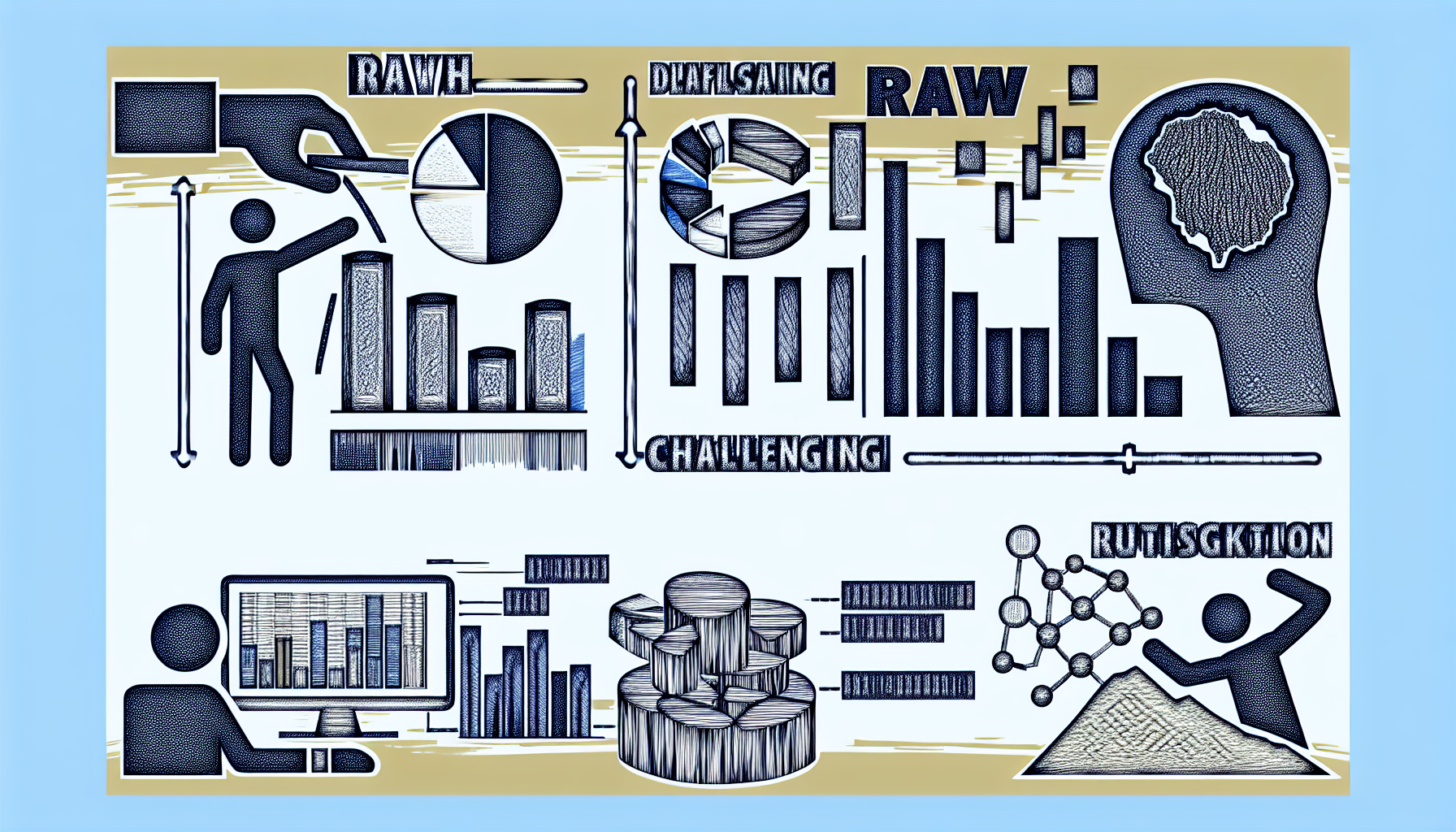
Raw data, often referred to as unprocessed data, is the primary output from various data collection processes. It encompasses a variety of types, such as text, images, audio, and numerical values. Typically, raw data is collected from diverse sources like surveys, sensors, databases, and online transactions, making it essential for organizations to analyze data accurately. However, this data often presents a host of challenges that require attention before any meaningful analysis can take place.
One of the most critical issues associated with raw data is the presence of “dirty data.” This term refers to inaccuracies and inconsistencies within datasets, such as misspellings, missing values, duplicates, and outliers. These discrepancies can arise from human error during data entry, technical issues during data collection, or even limitations in original coding frameworks. The presence of dirty data can lead to erroneous conclusions, impacting the overall quality of data analysis and decision-making processes.
Additional challenges related to raw data include its unstructured nature and volume. Raw data is often generated in massive quantities, requiring significant storage space and computational power for processing. Moreover, unstructured data lacks a predefined format, complicating efforts to sort and analyze it systematically. Consequently, organizations need to implement robust data cleaning techniques to address these concerns and convert raw data into a more structured and usable format.
Furthermore, the variety of data sources introduces complexity in integrating datasets, as differing formats or units of measurement can hinder a cohesive analysis. To navigate these challenges, data professionals must understand the characteristics of raw data and anticipate common issues, paving the way for effective data cleaning and wrangling solutions. Enhancing data quality is crucial for maintaining accuracy and reliability in subsequent analyses.
The data cleaning process is a critical phase in data wrangling, where raw data is meticulously transformed into a usable format. This preparation is essential for effective analysis and decision-making. The first step in this process typically involves data auditing, where the integrity, accuracy, and completeness of the dataset are evaluated. During this phase, analysts identify missing values, duplicate entries, and anomalies that need to be addressed. Data auditing sets the groundwork for subsequent steps in the cleaning journey.
Following the audit, cleaning operations are performed to address the identified issues. This involves several techniques such as removing duplicates, correcting errors, and filling in missing values. It is vital to choose appropriate methods for addressing missing data, which could include imputation techniques or simply omitting incomplete records, depending on the context of the analysis. Standardizing data formats, such as date formats and categorical variables, is also crucial, as inconsistencies can hamper analysis and lead to incorrect conclusions.
Once the data is cleaned, validation comes next. This step ensures that the cleaning operations were effective and that the data now meets the required quality standards for analysis. Techniques such as cross-verification with original data sources and consistency checks are often employed at this stage. Any remaining issues should be resolved before moving forward.
In summary, the data cleaning process involves a systematic approach that includes auditing, cleaning, and validating. Understanding this process is fundamental for mastering data wrangling and ensures a foundation for effective data analysis. The subsequent sections will delve deeper into specific techniques and methodologies that can be utilized throughout this critical stage of data preparation.
In the realm of data wrangling and cleaning, missing data presents a significant challenge. It is common to encounter situations where datasets have incomplete records, which can undermine the integrity of analysis. Thus, identifying missing values is the first essential step in preparing data for effective analysis. Various techniques can be utilized for this purpose, including visual inspection, statistical methods, and automated algorithms. Data visualization tools, such as heatmaps, can quickly highlight patterns of missingness, allowing analysts to pinpoint problem areas within the dataset.
Once missing data has been identified, several strategies can be employed to handle it. The most straightforward approach is deletion, which involves removing rows or columns with missing values. While this method can be efficient, it may lead to substantial data loss, particularly if the missing data is widespread. Therefore, it is crucial to assess the impact the deletion could have on the remaining dataset and subsequent analysis.
Another common method is imputation, where missing values are replaced with substituted values based on other available data. This can be achieved through various techniques, such as mean, median, or mode substitution for numerical data, or using more advanced methods like regression imputation or k-nearest neighbors. Each imputation technique carries its own potential bias, which can affect the quality of the dataset. Therefore, it is essential to carefully consider the choice of imputation method based on the nature of the data and the extent of missingness.
Moreover, evaluating the underlying reasons for missing data can provide insights that influence the chosen strategy. For example, if data is missing at random, imputation methods may be suitable. In contrast, systematic missingness might call for more complex solutions. In conclusion, identifying and handling missing data is a critical component of data cleaning. The decisions made during this process significantly impact the overall quality and reliability of the dataset, ultimately affecting the outcomes of any analyses performed. Ensuring a thoughtful approach can enhance the effectiveness of subsequent analytical efforts.
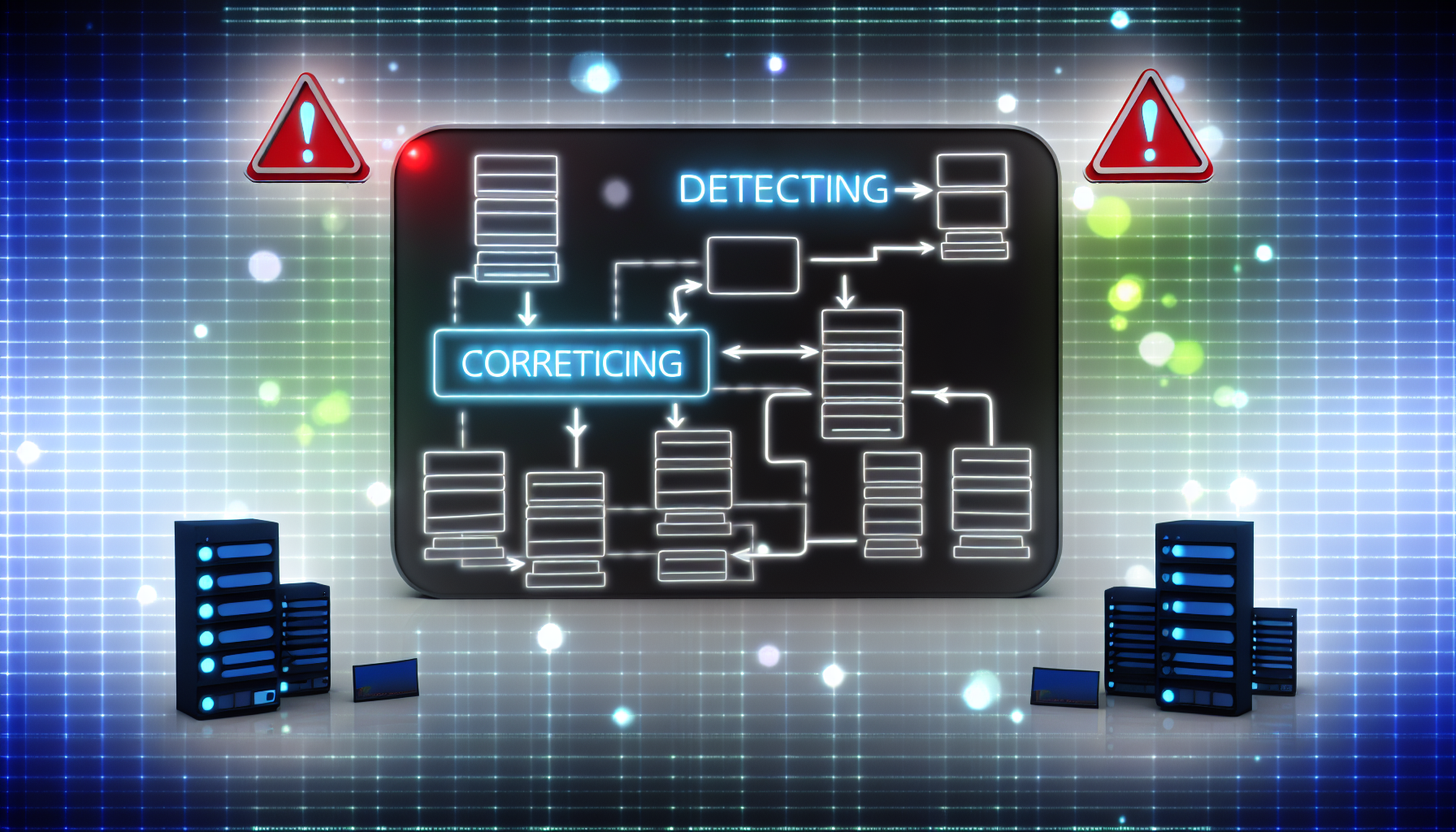
In the realm of data analysis, the integrity of the dataset is paramount. Data errors, including duplicates, outliers, and inconsistencies, can lead to misleading conclusions if not addressed properly. Recognizing these common issues is the first step in ensuring accurate analysis. Duplicates can occur during data collection or integration processes, where the same data point may be recorded more than once. This redundancy can skew analytical results and needs to be identified and removed. Techniques such as using unique identifiers or employing software tools that highlight duplicates can aid in this process.
Outliers, or data points that significantly differ from the rest of the dataset, pose another challenge. They can arise from measurement errors, transcription mistakes, or they may indicate genuine anomalies worthy of investigation. Visualizing data through scatter plots or box plots is effective for detecting outliers, as these methods allow analysts to quickly discern which data points lie outside expected ranges. Once identified, analysts must determine whether to investigate the cause of the outlier, modify the data, or consider its impact on the overall analysis.
Inconsistencies can also plague datasets, particularly when data is sourced from multiple databases or human inputs. For example, differing formats for dates or variations in categorical data (such as “Male” vs. “M”) can create confusion in analysis. Standardizing data entries is a critical corrective measure. Implementing data validation rules during the data entry phase can minimize these discrepancies. Furthermore, utilizing data profiling techniques can help to regularly audit data to uncover and rectify inconsistencies, thus maintaining the robustness of the dataset.
By employing these techniques for detecting and correcting data errors, analysts can ensure that their datasets are clean, consistent, and ready for effective analysis. Whether addressing duplicates, outliers, or inconsistencies, a methodical approach is essential for upholding data quality.
Data transformation is a crucial step in preparing raw data for effective analysis. This process involves modifying data into a suitable format or structure to enhance its usability and analytical potential. Various techniques, including normalization, scaling, and encoding, play a significant role in this preparation phase.
Normalization is a technique used to adjust the range of numerical data to ensure consistency. It can prevent certain features from dominating the analysis results due to their scale. For instance, in a dataset where one feature is in the range of thousands and another is in single digits, normalization scales the data to a common range, thereby improving model performance. Common normalization methods include Min-Max scaling and Z-score standardization, both of which help promote uniformity across the data set.
Scaling, while sometimes used interchangeably with normalization, specifically refers to adjusting the data range or distribution. This technique can significantly affect models that are sensitive to the scale of features, such as gradient descent-based algorithms. By ensuring features have a similar scale, scaling improves the convergence speed during the training phase of models, such as support vector machines or neural networks. Thus, choosing an appropriate scaling method is vital for optimizing data analysis results.
Encoding categorical variables is another essential technique in data transformation. Since many machine learning algorithms require numerical input, converting categorical variables into numeric formats is necessary. Common methods for encoding include one-hot encoding and label encoding. One-hot encoding creates binary columns for each category, ensuring that information is retained without implying any ordinal relationship among categories. In contrast, label encoding assigns unique integers to each category, a method that is efficient for ordinal data.
In summary, employing effective data transformation techniques like normalization, scaling, and encoding categorical variables is pivotal in maximizing the effectiveness of data analysis. By ensuring that the raw data is well-prepared, analysts can derive more meaningful insights from their datasets, ultimately leading to higher-quality and actionable outcomes.
Data formats and structures play a pivotal role in the manipulation and analysis of raw data. Various formats, including JSON, CSV, and SQL, each serve unique purposes and have distinct implications for data wrangling and cleaning processes. Understanding these differences is essential for effectively managing data across different mediums and for ensuring that the data analysis is accurate and insightful.
Comma-Separated Values (CSV) is one of the most widely used data formats, primarily due to its simplicity and compatibility with numerous data analysis tools. CSV files are structured as plain text files containing rows of data entries, with each entry separated by a comma. This format makes it easy to import data into applications such as Excel or Python libraries like Pandas. However, CSV lacks inherent support for complex data types, which can present challenges in data cleaning when dealing with nested or hierarchical datasets.
On the other hand, JavaScript Object Notation (JSON) offers a more flexible structure, making it suitable for representing complex data hierarchies. JSON data structures consist of key-value pairs, which makes them particularly effective for web applications and APIs. When managing data in JSON format, one must consider methods for flattening nested structures to facilitate data analysis and cleaning. JSON’s capacity for nested data allows for a richer representation of information, but it requires thorough preprocessing to ensure it is converted into a usable format for downstream analysis.
Structured Query Language (SQL) is yet another critical format in the realm of data management. SQL databases allow for data organization in tables that can be easily queried and manipulated. SQL excels in managing large datasets and supports complex operations like joins and aggregations. However, it also necessitates a deep understanding of relational database design principles, which can affect how data is cleaned and prepared for analytical tasks.
In summary, awareness of different data formats such as CSV, JSON, and SQL, alongside their corresponding structures, is indispensable for successful data wrangling. Effectively navigating these formats enhances not only the cleaning process but also the overall data analysis workflow.
In the realm of data analysis, the significance of data cleaning cannot be overstated. Leveraging automation tools and libraries can significantly expedite this process, allowing analysts to focus on interpreting data rather than rectifying it. There are several tools available that are specifically designed to enhance the efficiency of data cleaning tasks. Among these, OpenRefine stands out. It is an open-source tool that facilitates data cleanup by allowing users to transform and enrich messy data sets efficiently. With its powerful features, users can easily identify duplicate entries, detect anomalies, and execute batch edits across multiple records.
Another effective library for data cleaning is Pandas, widely used within the Python programming community. Pandas provides robust data manipulation capabilities, enabling users to easily handle missing values, filter data, and apply custom transformations through its intuitive DataFrame structure. It is particularly advantageous for users familiar with Python, as it integrates seamlessly with other analytical libraries, offering a comprehensive solution for data manipulation.
On the other hand, Dplyr is a popular choice among R users. This library streamlines the data cleaning process by offering a set of functions optimized for data manipulation within R. The syntax of Dplyr is designed to be user-friendly, making it accessible for both novice and experienced users. With functions like mutate(), filter(), and summarize(), Dplyr allows quick execution of common tasks required during the data cleaning phase.
To further enhance efficiency, analysts can adopt automation strategies such as scripting repetitive tasks. Creating scripts using either Python or R allows users to execute a series of data cleaning actions with minimal manual intervention. This not only saves time but also enhances the consistency of the results by reducing the scope for human error. By harnessing the capabilities of these tools, data professionals can streamline their cleaning processes, paving the way for more effective and insightful data analysis.
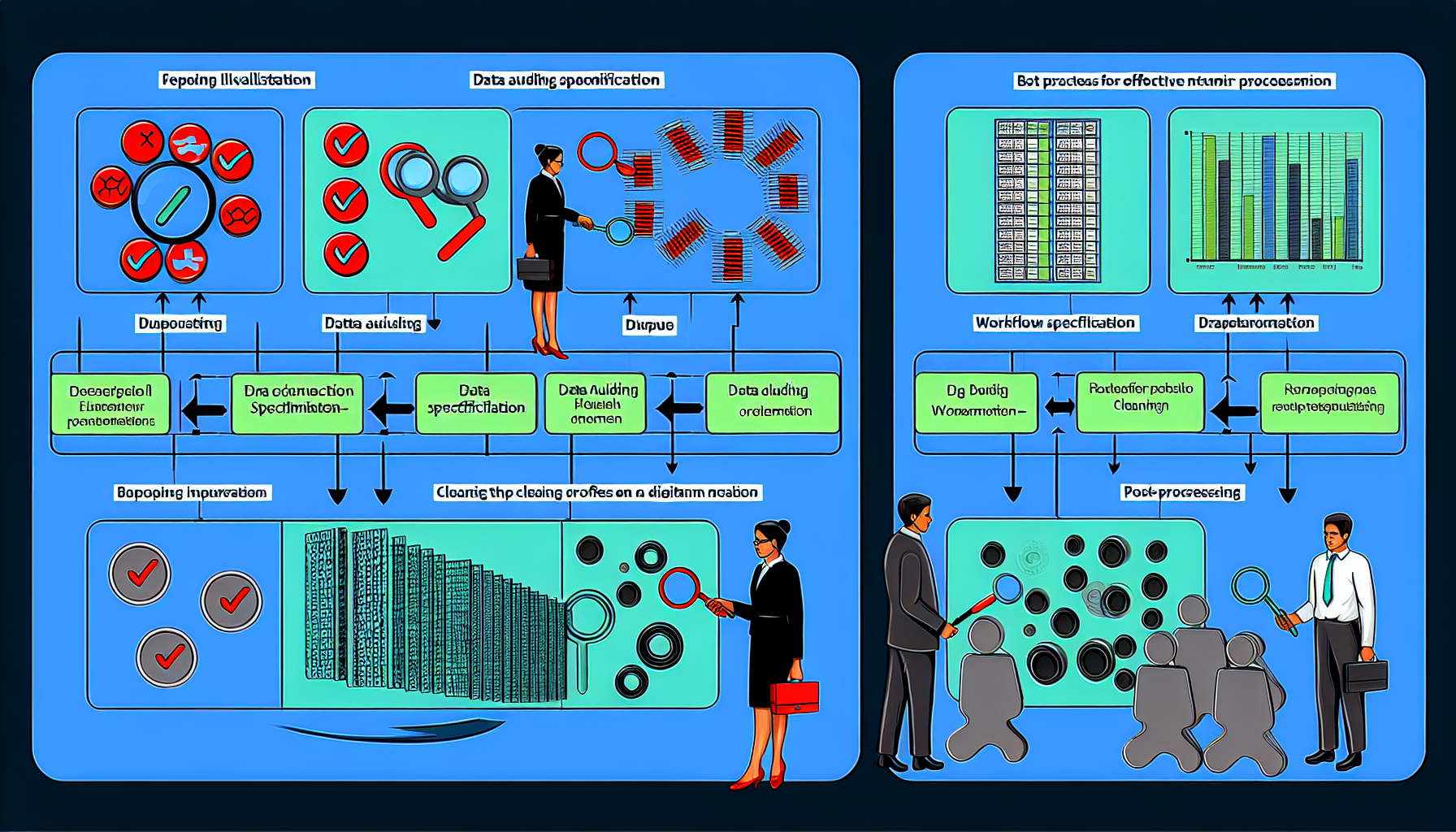
Effective data cleaning is a critical step in the process of data wrangling, establishing a reliable foundation for subsequent analysis. One of the fundamental best practices is thorough documentation of the data cleaning process. This documentation not only aids in understanding the transformations applied but also ensures that methods can be replicated or adjusted in future analyses. Maintaining clear and detailed records of data sources, cleaning techniques, and the rationale behind transformations promotes transparency and fosters collaboration among team members.
Regular audits of data quality play a significant role in maintaining the integrity of the dataset. Establishing a routine inspection schedule allows for the identification of data anomalies or inconsistencies, which can arise from various sources, including data entry errors or system malfunctions. By proactively addressing these issues through systematic audits, organizations can ensure that the data remains up-to-date and reliable for analysis. Additionally, implementing automated checks that flag uncommon patterns can be beneficial in maintaining a high quality of data without overwhelming human resources.
Following a consistent workflow for data preprocessing is another crucial practice for effective data cleaning. This typically involves defining a clear sequence of steps, which may include data extraction, transformation, loading (ETL), and validation. Adopting standard protocols for each phase of data cleaning minimizes the risks of oversight and increases efficiency. Consistency helps in building a repeatable process that can be adapted for various datasets, ultimately leading to higher-quality outcomes in data analysis. By integrating these best practices, organizations can enhance their data management strategies, enabling them to derive meaningful insights from their datasets more efficiently.
In the realm of data analysis, effective data cleaning is paramount for producing precise results that can significantly influence decision-making processes. This section explores real-world case studies where companies implemented structured data cleaning methodologies, resulting in transformative outcomes.
One notable example is a healthcare organization that aimed to improve patient care through data-driven insights. Initially, the organization faced issues with inconsistent patient records, leading to delayed treatments and adverse outcomes. By employing a systematic data wrangling approach, they standardized the data entries across various departments. This included implementing rigorous validation checks and creating a unified data entry protocol. The result was a dramatic enhancement in patient record accuracy that allowed healthcare providers to access reliable information swiftly, ultimately improving the quality of care delivered and increasing patient satisfaction rates.
Another compelling case comes from the retail sector, where a major chain was observing declining sales and customer engagement levels. The root cause was traced back to poorly maintained inventory data, causing stock discrepancies that affected product availability. The company undertook an extensive cleaning and preparation phase, which involved identifying and rectifying errors in the inventory data. Advanced analytics were applied to eliminate duplicate records and enhance the accuracy of stock levels. As a result, not only did their sales rebound, but they also achieved a higher level of customer trust, leading to increased loyalty and repeat purchases.
Lastly, a financial services firm turned to data cleaning to streamline their reporting processes. Inaccurate data entries were causing compliance issues and misinterpretations in financial reports. Through meticulous data preprocessing, they implemented an automated system for data cleansing that drastically reduced human errors and improved report accuracy. This enhancement fostered better decision-making and instilled a greater sense of confidence in clients and stakeholders regarding the firm’s financial health.
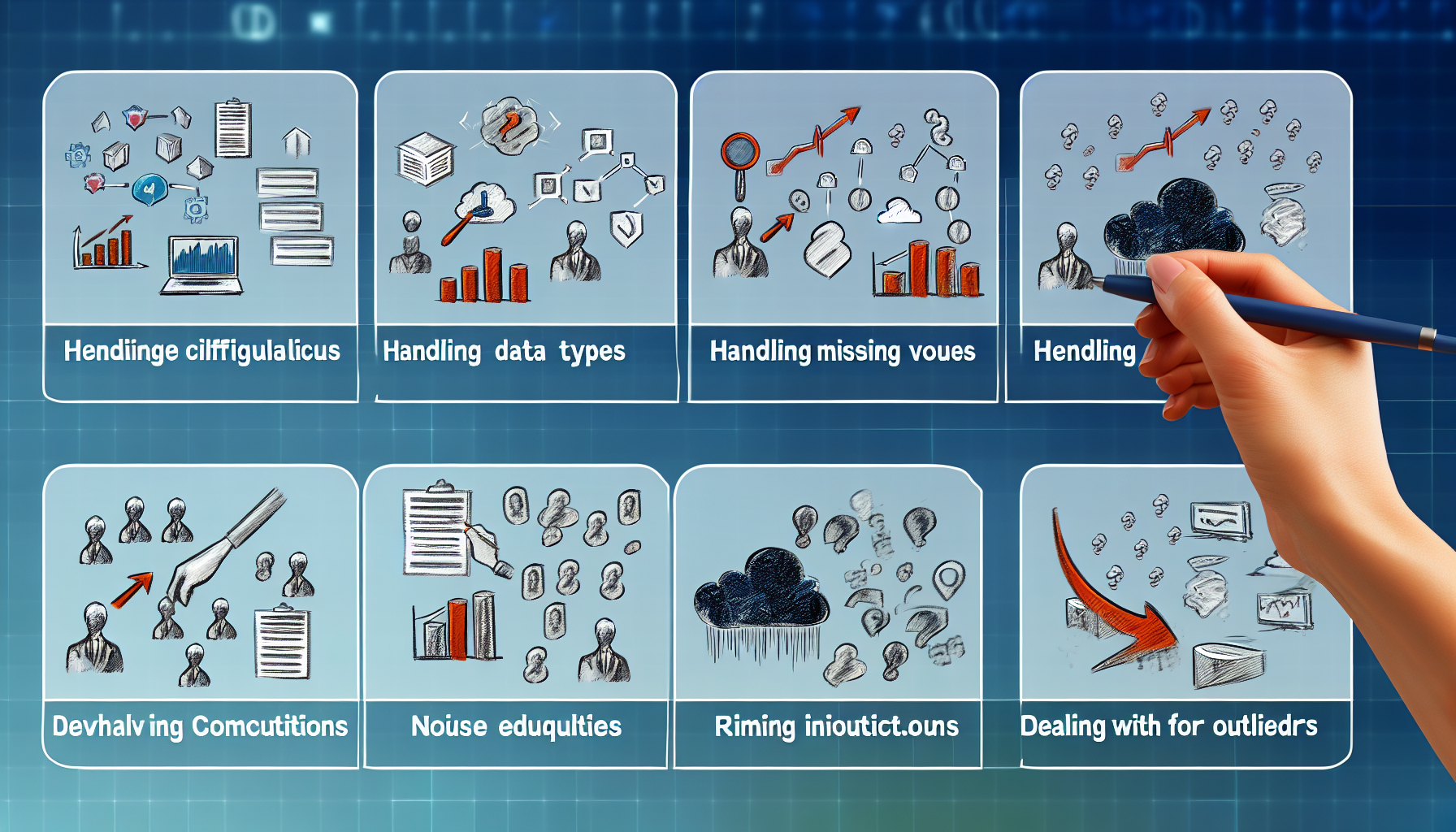
Data cleaning is a vital step in the data analysis process, yet it presents numerous challenges that analysts must navigate to ensure accurate and insightful outcomes. One primary challenge is managing large datasets. As the volume of data generated continues to grow exponentially, analysts may find themselves overwhelmed by the sheer size and complexity of their datasets. This can lead to performance issues and prolonged processing times. To mitigate this challenge, data analysts can employ sampling techniques, reducing the dataset size for preliminary analysis while ensuring the overall representativeness of the sample. Additionally, leveraging efficient data management tools can significantly enhance performance and streamline the cleaning process.
Another challenge arises from handling various data sources. Modern data analysis often involves integrating data from multiple platforms and formats, leading to inconsistencies and compatibility issues. To address these discrepancies, analysts should develop a robust data integration plan that defines a standard data model, ensuring uniformity across different sources. Data transformation techniques, such as normalizing data formats and consolidating similar fields, are essential for achieving seamless integration and maintaining data quality.
Furthermore, compliance with data privacy regulations is a crucial aspect that data analysts must consider during the cleaning process. With an increasing focus on data protection laws, including the General Data Protection Regulation (GDPR), data privacy must not be overlooked. Analysts must implement data anonymization techniques where necessary and ensure that sensitive information is appropriately protected. Establishing guidelines for data access and usage can help maintain compliance while allowing analysts to work effectively with the dataset.
By addressing these common challenges—large datasets, diverse data sources, and data privacy concerns—data analysts can enhance their data cleaning processes, laying the groundwork for effective analysis and insightful decision-making.
Once the data wrangling and cleaning processes have been completed, it becomes essential to evaluate the quality of the cleaned data. Assessing data quality is critical in ensuring that subsequent analysis is based on reliable, accurate, and valid information. Several methodologies and metrics can be employed to measure data quality, facilitating a comprehensive understanding of the cleaned dataset.
One of the foremost approaches to evaluate data quality involves the use of specific metrics that address various dimensions of data, such as accuracy, completeness, consistency, timeliness, and relevance. Each of these dimensions plays a vital role in the integrity of the dataset, influencing the overall outcomes of the analysis. For instance, accuracy refers to how closely the data reflects the actual situation or condition it represents, while completeness addresses the extent to which all required data is present.
Aligning with these metrics, employing data profiling techniques can be beneficial. Data profiling allows analysts to summarize the characteristics of the dataset and uncover discrepancies, outliers, or anomalies. By using statistical tools to calculate anomalies or unexpected behaviors in data distribution, professionals can identify areas where the data may still require attention. Automatic tools that provide data profiling reports can expedite this evaluation process significantly.
Moreover, validation against known benchmarks or previous datasets can serve as an insightful method for assessing data quality. For example, comparing the cleaned data against verified external datasets can help confirm accuracy and authenticity. Additionally, soliciting feedback from domain experts can provide practical insights into the validity and usability of the data.
In conclusion, measuring data quality after the cleaning process is an indispensable step in preparing data for effective analysis. By utilizing various metrics and employing thorough profiling techniques, organizations can ensure that their analyses are built on solid, reliable foundations, ultimately leading to better-informed decisions.
In the realm of data analysis, data wrangling and cleaning emerge as foundational practices that significantly influence the quality and reliability of outcomes. This blog post has underscored the multifaceted nature of data preprocessing, highlighting its essential role in transforming raw data into structured formats suitable for analysis. The insights shared demonstrate that effective data wrangling not only enhances the accuracy of analytical results but also streamlines the overall workflow, allowing analysts to focus more on deriving insights rather than grappling with data inconsistencies.
Moreover, as data landscapes continue to evolve, the importance of meticulous data cleaning cannot be overstated. By employing robust techniques, analysts can mitigate errors, ensure consistency, and improve the interpretability of data. This practice is paramount for decision-making processes across various sectors, as inaccurate data can lead to misguided strategies and undesirable outcomes. Throughout the section, we have explored how embracing data wrangling techniques aids in identifying anomalies, filling gaps, and optimizing datasets for further analysis.
Ultimately, the ability to master the art of data wrangling and cleaning is crucial for anyone aspiring to achieve success in data analysis. It is advisable for analysts and organizations alike to integrate these practices as a standard part of their operational workflow. By doing so, they will not only enhance the efficacy of their analyses but also cultivate a culture of data-driven decision making. In summary, effective data wrangling and cleaning lay the groundwork for insightful analysis, empowering analysts to transform raw data into valuable information that can drive impactful business outcomes.
Looking to advertise, promote your brand, or explore partnership opportunities?
Reach out to us at
[email protected]
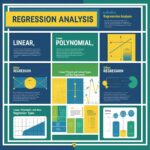











Chose where you want to study, and we will let you know with more updates.